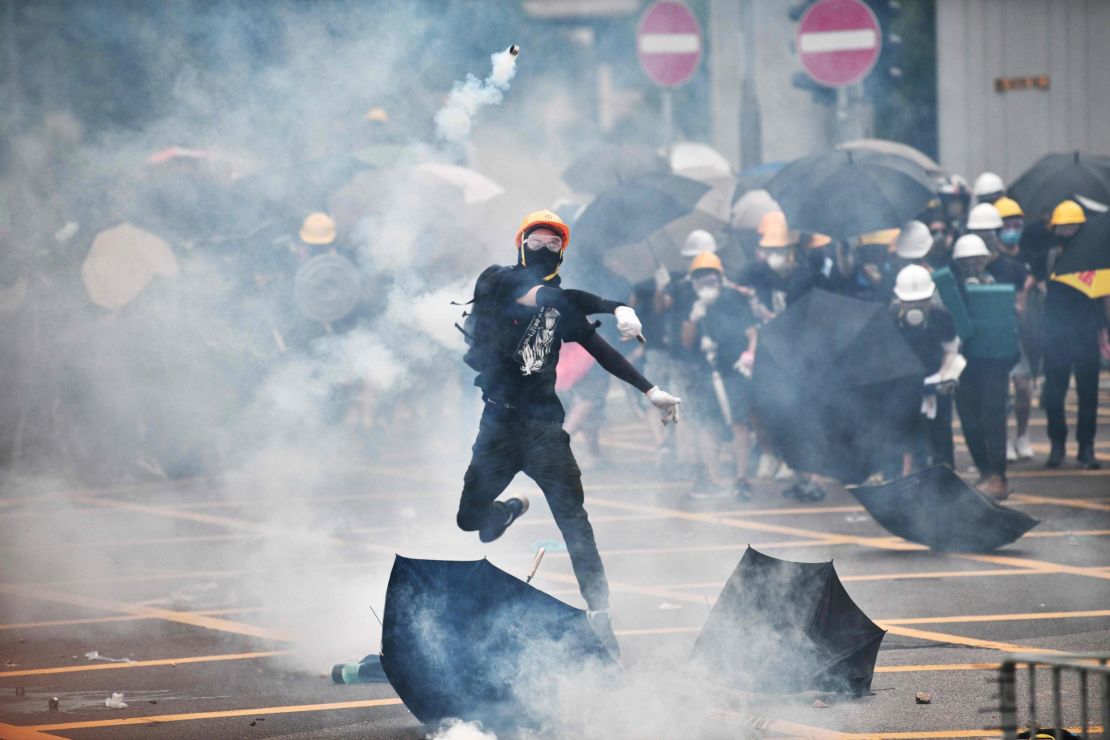China’s top Hong Kong policy office will on Monday address the escalating protests in the semi-autonomous city over the past eight weekends.
The unrest reached fever pitch Sunday when riot police fired tear gas and rubber bullets at protesters as the two groups fought pitched battles in residential areas. It was the second day of protests in a row amid the deepening political crisis that shows few signs of deescalating.
Beijing’s office dealing with Hong Kong and Macau affairs will give its first briefing on the issue from the Chinese capital at 3 p.m. local time Monday.
On Sunday, protesters defied police orders to march through the center of the city, with groups splintering in different directions and blocking major roads. Many wore black, the adopted color of the protest movement, and carried signs condemning alleged police brutality.
Riot police confronted hundreds of mainly young protesters who tried to reach the Chinese government’s Liaison Office. During demonstrations last weekend, activists vandalized the building and flung paint at the national emblem, drawing a furious reaction from Beijing.
The situation quickly deteriorated. Police fired multiple rounds of tear gas and rubber bullets at protesters, turning nearby streets into smoke-filled battlegrounds. Protesters, many of whom had armed themselves with improvised shields and bamboo sticks, fought back, hurling bricks, eggs and other objects at police lines. The two groups continued in a tit-for-tat struggle, with protesters at one point setting a cart on fire and pushing it in the direction of police.
The violence brought much of central Hong Kong to a standstill, as tear gas permeated the air forcing shops to shut and trapping residents inside buildings. In the residential area of Sheung Wan, many people were left stranded after the subway suspended west-bound services and major thoroughfares were closed.
Sunday marked the eighth consecutive weekend of mass demonstrations in Hong Kong. Hundreds of thousands of people have taken to the streets since the protests began two months ago, plunging the city into its most serious political crisis since its return to China in 1997.
Originally sparked by opposition to a controversial and now-shelved bill that would have allowed extradition from Hong Kong to China, the demonstrations have evolved to include calls for greater democracy, an independent investigation into alleged police brutality and the resignation of the city’s leader, Carrie Lam.
Demonstrators on Sunday initially met in Chater Garden in downtown Hong Kong, close to the Hong Kong government headquarters. Police had approved the rally but denied protesters’ application to march through the city, citing the “high” risk of violent clashes – the second time authorities have rejected a protest permit following a ban on yesterday’s march in Yuen Long.
Ventus Lau, 25, one of the organizers of Sunday’s protest, called the police decision “unreasonable,” saying such logic would prevent “peaceful protests” in the future.
“This is a serious threat to our freedom of expression in Hong Kong,” Lau added.

More violence in Yuen Long
Sunday’s protest came a day after riot police and protesters clashed in the small town of Yuen Long, near Hong Kong’s border with China.
Yuen Long became an unlikely focal point of the city’s pro-democracy movement after protesters returning to the town from a march in downtown Hong Kong last weekend were viciously attacked by a mob wielding iron bars and bamboo sticks.
About a dozen men have been arrested in connection with that attack, some of whom have links to organized crime groups, or triads. Protesters were reportedly at the mercy of the mob for almost an hour before police arrived and at least 45 people were injured, some seriously.
On Saturday, protesters – many wearing black – returned to the district, chanting “There is no riot only a tyranny” and “Hong Kong Police, the lawbreakers” as they thronged through the streets in sweltering summer temperatures.
Police initially appeared unwilling to intervene, but as dusk approached, hundreds of officers in full riot gear advanced on demonstrators.
The crowd quickly thinned, but a core of several hundred mostly young protesters in hard yellow helmets and protective gear, appeared unwilling to back down – charging police lines and forming barricades.
In response, police fired tear gas and rubber bullets at demonstrators. A small group of front line protesters threw bricks and other materials at police as the two sides fought for several hours.
As night fell, additional riot police advanced from multiple angles slowly pushing demonstrators in the direction of Yuen Long metro station, in a final bid to clear the streets. Chaos briefly reigned inside the station when riot police charged up the stairs with batons, hitting protesters and using pepper spray.
Twenty-four people between the ages of 15 and 60 were hospitalized following the clashes, authorities confirmed. Two were in a serious condition.
In statement Saturday, Hong Kong police reiterated that the demonstration had been an “unauthorized assembly” and accused protesters of throwing bricks and “hard objects” at officers during violent clashes.
The protest in Yuen Long followed a large peaceful demonstration at the city’s international airport Friday night. Thousands of protesters joined aviation staff in occupying the arrivals hall, where they greeted passengers with chants of “Free Hong Kong” and “Justice for victims of brutality.”






















